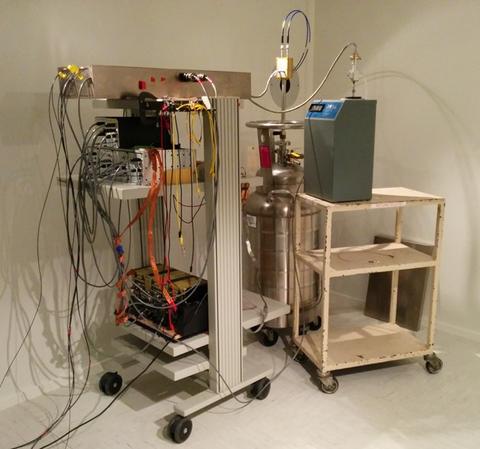Summary
The Noise Thermometry Project is applying quantum-based voltage waveform synthesis to a precision measurement of Boltzmann's constant kB by developing a primary temperature standard based on the electrical measurement of the Johnson-Nyquist voltage noise of a resistor at the triple-point temperature of water.
Description

NIST Johnson Noise Thermometer system for precision electronic measurement of Boltzmann's constant.
The project has also created a quantum-based electronic temperature standard that uses the ACJVS in conjunction with measurement of the Johnson noise -- random electrical noise caused by thermal agitation in a conductor -- in resistors at arbitrary temperatures. This Johnson noise thermometry system is in use at NIST's Physical Measurement Laboratory in support of work aimed at reducing uncertainty in temperature measurements and improving the understanding of the international temperature scale, the standard for measurements made in the Celsius and Kelvin, as well the development of a novel electronic method for determining the Boltzmann constant, a fundamental constant of nature that relates temperature and energy.
Just as the measurement of Planck's constant h by the NIST watt-balance experiment will soon replace the international kilogram artifact standard with an "electronic kilogram", the NIST Johnson Noise Thermometer (JNT) may eventually replace the large collection of temperature fixed points (temperature artifact standards) that define the ITS-90 thermodynamic temperature scale. Most importantly, JNT is providing a unique electronic measurement of the Boltzmann constant, which is important for the 'New SI' (New International System) redefinition that is anticipated in 2017. The value of kB is presently determined exclusively by acoustic gas thermometry measurements, so it is very important to have an alternative determination using an entirely different physical measurement technique, such as the electronic technique of JNT. NIST published the first electrical measurement of Boltzmann's constant in 2010, which contributed to CODATA and agreed with the previous SI-assigned temperature of +0.5 μK/K ± 12 μK/K. The most recent JNT measurement resulted from a 2014 NIST collaboration with NIM China, which reduced the combined measurement uncertainty to ~4 μK/K. This lower-uncertainty result was accomplished by a new pulse-bias technique for the quantum voltage waveform synthesizer that reduces some frequency-dependent systematic error signals and improved modelling of the frequency-dependent fits. We anticipate further improvement in the uncertainty on kB based on new measurements at NIST within the year.

